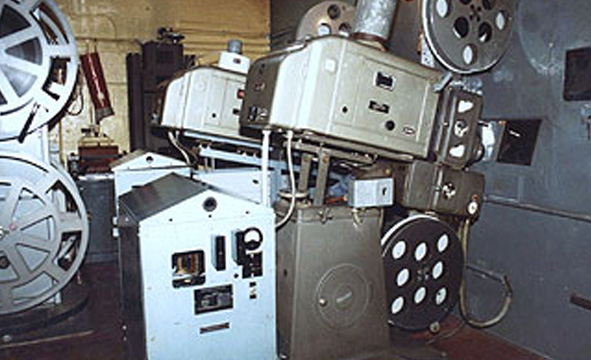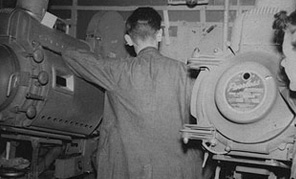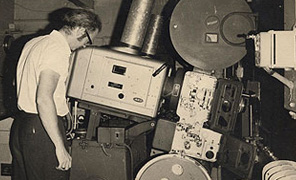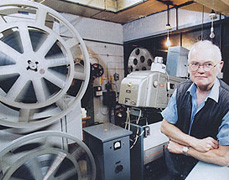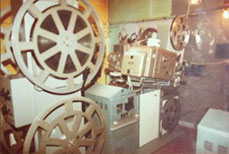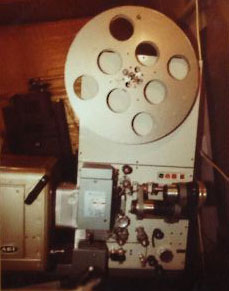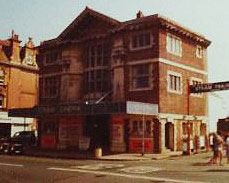 This picture was taken in the projection room of Paignton Picture House in 1980, when it contained two Westrex machines, with western electric sound, and zenon lamps providing the light source. The film was loaded on to a long running tower system sited behind the projectors. As far as we know some of this equipment is still there, but after all this time could well be beyond repair. The Paignton Picture House started with hand operated POWERS 35mm, which used a four pin intermittent system to pull the 35mm film past the arc lamp light source. Being the forerunner of moving pictures, slides were still shown, with short black and white moving films shown in between. Sound was often provided with a piano, but as films became longer with more story, a twenty one piece orchestra would play adding another dimension to the film being watched. The live sound of the orchestra would have been far superior to the first talking pictures which were to follow in the late 20s. The next machines to arrive in 1919 were two INDOMATBLES which were motor driven with low intensity arc lamps. In these early days the electricity supply was not up to today's standard, and often the striking and running of the arc lamp would cause major problems with other parts of Paignton town. A small film library was also in the cinema at this time and would lend films to other cinemas. Not long after, in the early 1920s, the INDOMATBLES were replaced with two GAUMONT CHRONOs (green backs). Still being silent machines, these projectors were not around long before the next big change - the coming of sound. ERNIMAN 3, picture heads coupled with MICRAPHONIC sound on disc and WESTERN ELECTRIC SOUND using the new optical sound system which would last in one form or another right up to today. Sound had arrived. The piano and orchestra were no longer wanted; to see and hear people talking, sound effects, and all the other sounds that we hear around us every day would now be brought into the cinema and would open up the unlimited world of storytelling. With the coming of sound a few changes had to be made to the front of house. Loud speakers had to be fitted, behind the screen being the best place, which meant the screen had to be brought forward, and made of a different material to allow the sound through. Sound and picture quality of the film improved over the next few years, so that by 1945, just after the 2nd World war, new WESTREX picture heads, PEERLESS MAGNARC LAMPHOUSES, coupled with WESTERN ELECTRIC sound and new speakers, bought Paignton picture house bang up to date. In 1954 the anamorphic lense came to the Paignton Picture House and alterations to the cinema to create a super widescreen image was made in 1964. Where as sound up to that date had been optical, now magnetic stripe was added to the film, and a new WESTREX sound reader had to be fitted for this, coupled with improved amplification. The old arc lamp-houses were replaced with three electrode zenon lamps, which could be very dangerous unless handled carefully, but did give a easily managed lighting system; also fitted around this time were new longer running spool boxes capable of taking 6000ft of film. Cinemascope meant another alteration to the front of house to make way for the new wide ratio screen, new Andrew Smith harness gallows tabs, better speakers for left and right to make the stereo image, completed the change. 1980 saw the installation of long running equipment, Paignton cinema being the first cinema in Devon to have the new tower system with 22000ft spools. This now made it possible to have around 2hrs of continuous running, so most of the show for the first time could be put on without numerous changeovers between two machines. A new WESTREX 7000 mark 3 projector was fitted which was designed for continuous running. With the arrival of DOLBY STEREO, a better quality sound could be achieved on the optical sound track. Over the years DOLBY made many improvements, from basic surround sound to the multi channels we have today, Paignton cinema kept up with some of these changes, and in 1994 made a major upgrade with a new J B L sound system. So over the years many changes in technology but not so many in the look and feel of the general building. |
The Paignton Picture House started
|


